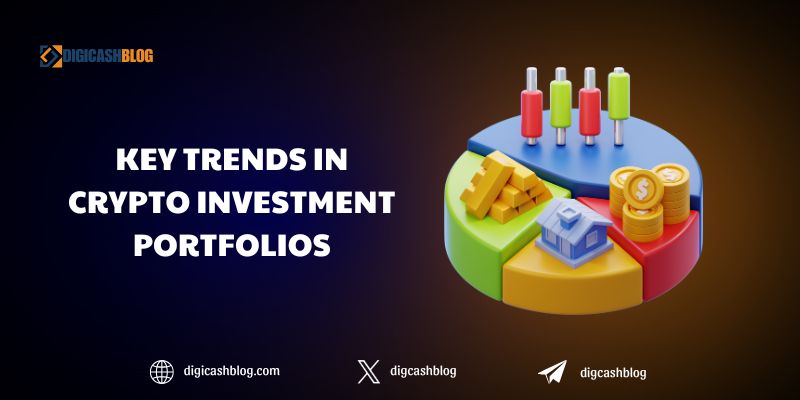The cryptocurrency market has evolved into a significant component of global finance, with a market capitalization reaching $2.66 trillion in 2025, driven by institutional adoption, regulatory advancements, and technological innovations. As investors diversify their portfolios, understanding the key trends in cryptocurrency investment portfolios for 2025 is crucial for navigating this dynamic landscape. This article explores the dominant trends shaping crypto investment strategies, drawing on recent market insights and forecasts to guide both retail and institutional investors.
Institutional Adoption and Bitcoin ETFs
One of the most transformative trends in 2025 is the surge in institutional adoption, particularly through Bitcoin Exchange-Traded Funds (ETFs). The approval of spot Bitcoin ETFs in January 2024 marked a turning point, enabling traditional investors to gain exposure to Bitcoin without directly holding the asset. Major financial institutions like BlackRock ($15 billion in Bitcoin assets) and Fidelity ($9 billion) have led the charge, making ETFs a cornerstone of institutional portfolios. These funds track Bitcoin’s market value, offering a low-cost, accessible entry point for retail investors and wealth managers handling 401ks or IRAs. In 2025, experts anticipate further growth in ETF offerings, potentially extending to altcoins like Ethereum, driving liquidity and mainstream acceptance.

Stablecoins as a Portfolio Stabilizer
Stablecoins are increasingly vital in cryptocurrency investment portfolios, providing stability in a volatile market. Pegged to fiat currencies like the U.S. dollar, stablecoins such as Tether (USDT) and USDe are used as a bridge for trading and as a hedge against price swings. In Q1 2025, the stablecoin market cap surpassed $200 billion, outpacing Bitcoin’s price growth. Projections suggest stablecoins will settle $300 billion in daily transfers by year-end, driven by adoption from tech giants (e.g., Apple, Google) and payment networks (Visa, Mastercard). For investors, stablecoins offer a low-risk component in portfolios, particularly for remittances and cross-border transactions, with monthly U.S.-Mexico stablecoin transfers expected to grow from $80 million to $400 million.
Diversification into Altcoins and DeFi Tokens
While Bitcoin remains the dominant asset, altcoins and Decentralized Finance (DeFi) tokens are gaining traction in diversified portfolios. In 2025, Layer 1 (L1) blockchains like Ethereum, Solana, and Cardano are popular for their smart contract capabilities, with Ethereum leading DeFi and dApp ecosystems. DeFi’s total value locked (TVL) is projected to exceed $200 billion by year-end, fueled by innovations in liquid staking and restaking. Altcoins like XRP, used for cross-border payments, and Solana, known for low transaction fees ($0.00025), are also portfolio staples. Investors are increasingly allocating to utility-driven altcoins in AI, gaming, and real-world asset (RWA) tokenization, as these sectors show strong growth potential.
Real-World Asset (RWA) Tokenization
RWA tokenization is a game-changer for 2025 portfolios, enabling fractional ownership of assets like real estate, commodities, and private equity. The RWA market grew to nearly $20 billion in Q1 2025, with projections to surpass $50 billion by year-end. Major institutions like BlackRock and Goldman Sachs are embracing tokenization, attracted by its efficiency and liquidity benefits. For investors, tokenized assets diversify portfolios beyond traditional crypto, democratizing access to previously illiquid markets. This trend aligns with the broader shift toward blockchain as a foundational technology for financial systems, reducing reliance on Bitcoin-centric speculation.
AI-Powered Crypto Investments
The intersection of artificial intelligence (AI) and cryptocurrency is a rising trend in 2025 portfolios. Blockchain-based AI platforms like Bittensor enable decentralized creation and monetization of AI tools, attracting investors seeking innovative exposure. AI-driven portfolio management tools are also gaining popularity, automating market analysis and predicting price movements. These tools enhance decision-making for retail investors, while projects like Ambient, backed by venture firms like a16z, integrate AI directly into blockchain operations, offering new investment opportunities. This trend is expected to grow as AI and blockchain converge to create secure, decentralized ecosystems.

Moving Averages in Crypto Portfolio Analysis
Moving Averages (MA), including Simple Moving Averages (SMA) and Exponential Moving Averages (EMA), are critical tools for managing cryptocurrency portfolios in 2025. These indicators smooth price data to identify trends and signal entry/exit points:
- SMA: The 50-day and 200-day SMAs are widely used to confirm long-term trends. For example, a Golden Cross (50-day SMA crossing above 200-day SMA) signals bullish momentum, as seen in Bitcoin’s 2024 rally.
- EMA: The 12-day and 26-day EMAs are favored for short-term trading, with crossovers indicating potential reversals. For instance, a bullish 12-day EMA crossover on Solana’s chart could prompt portfolio reallocation.
- Portfolio Application: Investors use MAs to time entries into assets like Ethereum or XRP, combining them with RSI or MACD for confirmation. For example, holding a position above the 50-day SMA can validate a bullish allocation strategy.
- Regulatory Clarity and Portfolio Confidence
Regulatory developments are shaping key trends in cryptocurrency investment portfolios for 2025. The U.S. Trump administration’s pro-crypto stance, including the repeal of the IRS’s DeFi broker rule and the appointment of crypto-friendly leaders, has boosted investor confidence. The EU’s Markets in Crypto-Assets (MiCA) regulation, while increasing compliance costs, provides clarity that encourages institutional participation. In South Africa, new exchange control regulations are integrating digital assets into the financial system, enhancing portfolio diversification. Regulatory certainty reduces risk perceptions, encouraging investors to allocate more to crypto assets.
